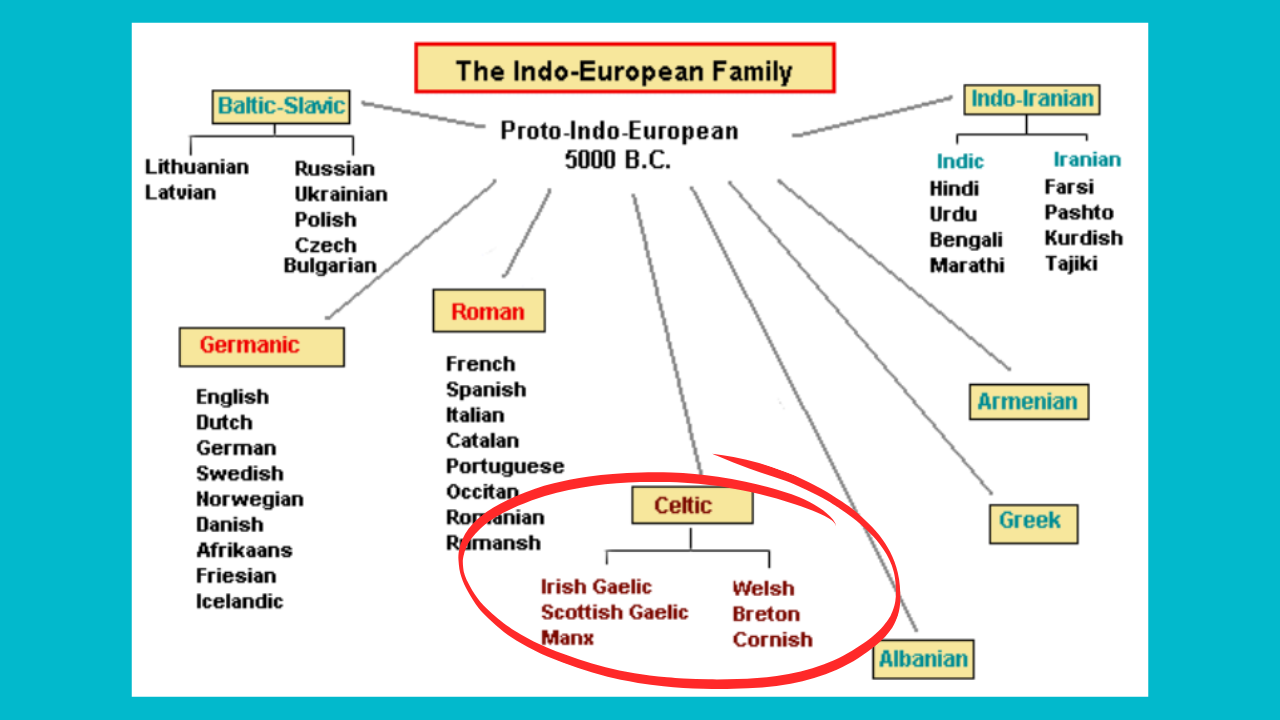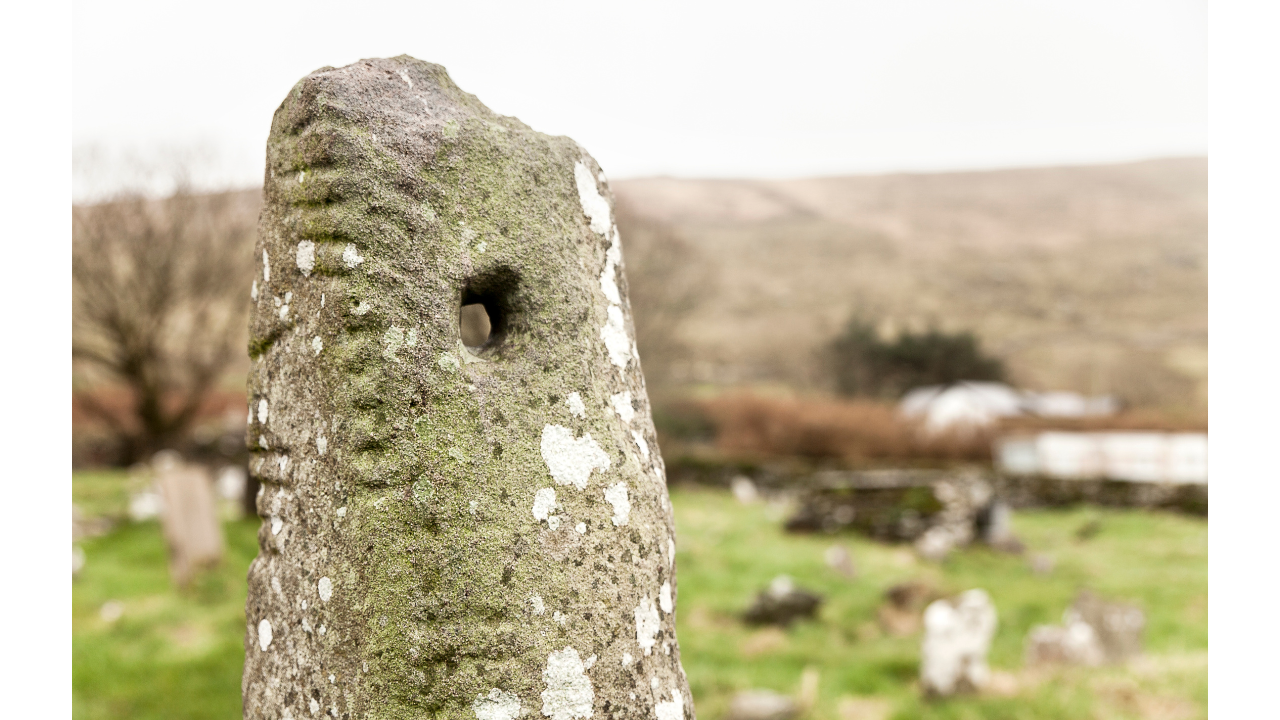
How old is the Irish language?
Here's the short answer:
It's old!
Very old!
The Irish language is older than English by more than a thousand years; and a form of the language has been spoken in Ireland for somewhere in the order of 2,500 years!
The origin of the Irish language
Irish belongs to a larger group of related languages called the 'Indo-European family'. All of the languages in this family evolved from one ancient language spoken thousands of years ago. Over time, as people moved and settled in different places, this ancient language, 'Proto-Indo-European' split into many branches.
Irish developed from one of these branches, the Celtic branch.
(Notice that English developed from the Germanic branch, an entirely separate branch. This means that English and Dutch or German contain more similarities than English and Irish, and for this reason German should, relatively speaking, be easier for an English speaker to learn than Irish.)

The Celts arrive in Ireland around 500BC
A group of culturally distinct people started to emerge in mainland Europe around 2000 BC. These people were described as keltoi by the Greeks and they spoke a precursor to the modern Celtic languages. They expanded across Europe, from as far east as parts of modern day Turkey to the Iberian peninsula in the west of Europe.
Around 500 BC tribes of these keltoi people began migrating into Britain and Ireland from continental Europe.
The language of the keltoi started to replace whatever language had been spoken in pre-Celtic Ireland, and pre-Celtic Britain.
Most archaeologists agree that by about 300 BC the Celts were probably dominant in Britain and Ireland.
The language the keltoi people spoke when they arrived in Ireland is the precursor to modern Irish, and it can be said therefore that a form of Irish has been spoken in Ireland for in or around 2,500 years!
The decline of the Celts on continental Europe
The expansion of the Roman empire delivered a fatal blow to the Celts on mainland Europe, and also in most of Britain. By 200 AD the replacement of Celtic speech by Latin was almost totally complete in those places. This meant that Ireland and parts of Britain (predominantly modern day Wales) remained the only places where this early Celtic language survived.
Because of its location on the fringes of Europe Ireland remained untouched by the Roman conquest and this allowed the early Celtic language to flourish in isolation, in contrast to its erasure on mainland Europe.
Ogham: The first written inscriptions
Very little is known about this early precursor to Irish, apart from the little information that can be gleaned from ancient stones known as Ogham stones.
An Ogham stone is a tall, narrow standing stone inscribed with markings. The markings are an ancient from of writing script, known as Ogham. The script consists of characters made up of lines or notches carved onto stone, or wood.
The inscriptions are usually pretty short (you try inscribing notches into stone and see how you get on!) and spell out names, or mark graves or land boundaries. These Ogham stones are scattered throughout Ireland, but are concentrated predominantly in the south west of the country.

Ogham stones date mainly from the fifth and sixth centuries, and provide a clue as to the primitive Irish which was developing in Ireland.
They represent the oldest written text of Primitive Irish.
Old Irish: 600 - 900 AD
It is not until about 600 AD that it becomes possible to really reconstruct the language as it would have been spoken in Ireland at the time. With the arrival of Christianity in Ireland in the 5th century Ireland became a centre of learning and culture. The Irish monasteries were filled with scribes not only copying out manuscripts in Latin, but also filling in the margins of the pages with commentary in their own language, Irish. The monks adapted the Latin alphabet to Irish and in doing so became the earliest adopters of writing in a vernacular (spoken) language in Europe.
In fact the written texts which appear in Old Irish as early as the 6th century, are centuries ahead of written text in any of the other spoken European languages of the time.
By way of comparison the first written text in French did not appear until 843 AD and Spanish text didn't appear until the 10th century. While some old English text did appear in the 7th century the first full sentence in English in Latin script dates dates to the 10th century.
Irish monks travelling across Britain and Europe in the 6th and 7th centuries were hugely influential in the spread of literacy in Britain and on mainland Europe.
The land of saints and scholars
Such was the influence of the monks in spreading literacy and learning that Ireland became known as the 'Land of Saints and Scholars' from around the 5th to the 12th century. Ireland became a major centre of learning and Irish monks and scholars played a significant role in preserving and spreading knowledge throughout Europe. The monks travelled from country to country establishing monasteries and centres of learning.
Conclusion: Irish is old, pretty damn old!
Irish developed from a proto-Celtic language brought to Ireland around 500 BC and a form of this native language has been continuously spoken on the island of Ireland for over two millenia! Irish is the oldest written vernacular language in western Europe, with texts dating back to the 6th century (long before other European languages took written form). Irish continues to be spoken today, some two thousand five hundred years since the first keltoi landed on Irish shores.
Older than the Cailleach Bhéara!
There is a saying that 'Irish is older than the Cailleach Bhéara', a poetic way to emphasise the ancientness of the Irish language. The Cailleach Bhéara (the Hag of Béarra) is a legendary figure in Irish mythology, a wise, ancient woman who lived for generations. She represents both the land and time itself, and has endured and survived for years and years. Comparing the language to the Hag of Béarra is to emphasise the resilience of this language, that has also endured for generation after generation, for more than two thousand years!
Learning Irish
If you find the initial stages of learning Irish a little challenging bear in mind that you are learning a language from an entirely different language family to your own (unless you speak another Celtic language such as Welsh or Breton). This means that the learning curve might be a little steeper at the start than if you were to learn a Germanic language.
Coinnigh ort!
Keep going!
You can be part of the chain of people that have kept the Irish language alive for well over two thousand years.
If you want a little help learning Irish make sure to check out the All About Irish Beginner Irish course. There are also courses suitable for intermediate and more advanced learners. All of the information on the various courses is available here.
All About Irish online Irish language courses are a great way to learn Irish in your own time and at your own pace.

